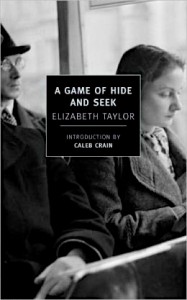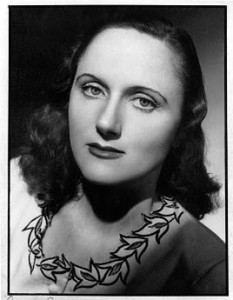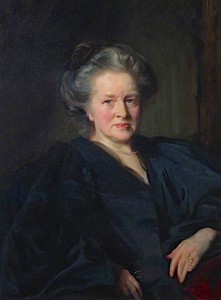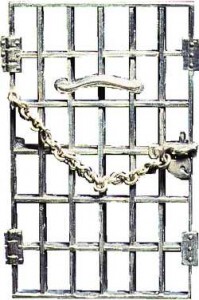Note: Critic Philip Hensher describes Elizabeth Taylor as “one of the hidden treasures of the English novel.” Kingsley Amis named her “one of the best English novelists born in this century”; Antonia Fraser called her “one of the most underrated writers of the 20th century.” Hilary Mantel says that she is “deft, accomplished and… underrated.”–The Guardian, May 11, 2012
.
“Another day is another world…Not only are the landscape and the light changed, but people are different, relationships which the night before had progressed at a sudden pace, appear to be back where they were. Some hopes are renewed, but others dwindle: the state of the world looks rosier and death further off…we begin to regret promises…we do not love our friends so warmly…writers tear up the masterpiece they wrote the night before.”
 Author Elizabeth Taylor, who failed her entrance exams to university, never let that get in the way of her writing career. Like Angel in her novel of the same name, she began writing as a teenager, finishing her first novel before she was sixteen, and writing constantly ever after that. Unable to get any of her work published until she was in her early thirties, she made up for lost time, however, publishing six novels between 1945 and 1953, and five more between then and 1971. A Game of Hide and Seek, published in 1951 and recently republished as a New York Review Book Classic, is one of her most intensely psychological novels, the story of two young people who spend their time in self-imposed isolation, their paths crossing briefly when, as teenagers they find themselves sharing summer vacations. By the time Harriet Claridge and Vesey Macmillan are eighteen, they are being encouraged to entertain Harriet’s younger cousins to keep them busy during their summer vacation in the country, and they sometimes use hide-and-seek games played with the children to be together in private. They are, however, shy, innocent, and self-conscious, despite Vesey’s uncontrollable malicious streak (which Harriet sometimes thinks she deserves), and so they sit in the loft or the barn “in that dusty stuffiness, among old pots of paint, boxes of bulbs, stacks of cobwebbed deck-chairs, rather far apart and in silence…The only interruption was when one of them timidly swallowed an accumulation of saliva.”
Author Elizabeth Taylor, who failed her entrance exams to university, never let that get in the way of her writing career. Like Angel in her novel of the same name, she began writing as a teenager, finishing her first novel before she was sixteen, and writing constantly ever after that. Unable to get any of her work published until she was in her early thirties, she made up for lost time, however, publishing six novels between 1945 and 1953, and five more between then and 1971. A Game of Hide and Seek, published in 1951 and recently republished as a New York Review Book Classic, is one of her most intensely psychological novels, the story of two young people who spend their time in self-imposed isolation, their paths crossing briefly when, as teenagers they find themselves sharing summer vacations. By the time Harriet Claridge and Vesey Macmillan are eighteen, they are being encouraged to entertain Harriet’s younger cousins to keep them busy during their summer vacation in the country, and they sometimes use hide-and-seek games played with the children to be together in private. They are, however, shy, innocent, and self-conscious, despite Vesey’s uncontrollable malicious streak (which Harriet sometimes thinks she deserves), and so they sit in the loft or the barn “in that dusty stuffiness, among old pots of paint, boxes of bulbs, stacks of cobwebbed deck-chairs, rather far apart and in silence…The only interruption was when one of them timidly swallowed an accumulation of saliva.”

From this inauspicious beginning of the novel, which is further complicated for the reader because the first thirty pages of the novel “tell about” the past with little dialogue to enliven it, the author develops the relationship between Harriet and Vesey over the next thirty years. As a teenager enamored of Vesey but unsure of herself and of him, she obsesses over a quick kiss he gives her as he prepares to go on to school. Harriet has failed her exams, though her mother has had little hope that she would pass. Mother and daughter are not close, her mother, Lilian, having been a suffragette with Dr. Elizabeth Garrett Anderson, with whom she allowed herself to be jailed, while timid Harriet invents stories of meeting Vesey secretly, and writes in her diary in excruciating detail about every action or movement he makes. Vesey, too, is also isolated, but his reaction when he is in school is the opposite of Harriet’s. Instead of being timid, he becomes “disruptive, cheeky…and the same sort of little monkey that he had been at home.” Lazy and often mean-spirited, he teases his cousins during the summer, persuades them to eat meat, though the family is vegetarian, tells disgusting stories of corpse-eating, and makes dismissive comments about Harriet in front of the children. Somehow amidst all this, the two eventually exchange a passionate kiss which changes Harriet’s life forever, and when Vesey is sent home partway through the final summer, she is devastated.

Dr. Elizabeth Garrett Anderson was the first Englishwoman to qualify as a physician and surgeon in Britain, the co-founder of the first hospital staffed by women, and the first dean of a British medical school. A suffragette, Harriet’s mother went to jail with her. Portrait by John Singer Sargent
The novel divides into two parts. Eventually, Harriet meets Charles, “an elderly man of thirty-five,” a solicitor whose mother Julia is a free spirit who appears “to love her, who had singled her out.” Her own mother dislikes Charles’s mother almost instantly, which may be part of Julia’s attraction for Harriet. Still unmarried, Charles plays concert piano for Harriet and her mother when they visit. “Harriet tried to put on a polite and considering look. She loved the music, but could not allow herself to enjoy it among strangers. Sunk too far back in her too large chair, she felt helpless, like a beetle turned on its back…” It comes as no surprise as Harriet and Charles eventually connect, thanks to some of the beauty and courtship hints given to her by her uninhibited fellow-employees in the dress shop where she works, and though her feelings for Charles are closer to toleration than love, they eventually marry. Harriet’s personality changes after her marriage, and she becomes somewhat more assertive, more willing to take chances. Vesey, on the other hand, leaves Oxford and floats around as an actor. Occasionally, over the years, they meet, something that gives Harriet something to look forward to in her boring marriage, “a frayed and tangled thing made by two strangers.”

Harriet’s mother celebrates Women’s Suffrage each year by wearing her silver “Jailed for Freedom” pin, an embarrassment to Harriet.
Taylor creates effective overlaps in her story and characterizations as she examines her characters and their failings under a magnifying glass. Harriet’s daughter Betsy comes to resent Harriet, as Harriet did her own mother, confiding in one of her unmarried teachers, who gives her the support that she does not get at home. Charles develops some of the same kinds of malicious behavior we have seen with Vesey as a teenager. Betsy obsesses about an unrequited love, as did Harriet. Vesey begins to obsess about the past as Harriet once did, blaming Harriet for “panicking too soon” when she married. Characters do not say to others what they dream of saying, and they react dishonestly when they believe that they are sparing others the hurt that they themselves feel. Being polite and restrained are valued qualities among the people in Harriet’s life in this post-war society, and it is inherently dishonest. At one point Harriet recognizes the problem: “Nowadays, perhaps always, happiness has to be isolated. Only when we blot out all that surrounds it, can we have it perfect, as we so often have perfect grief.” She has values and a sense of responsibility which are necessary for society but often interfere with personal happiness.

Late in the novel Vesey reappears from playing a role at a theatre on the oceanfront, outside of London, perhaps this one in Southampton.
This novel, despite its slow start, becomes all-consuming as Taylor creates real people with real feelings from a society which is socially poles apart from our own. Still, she manages to make the reader understand Harriet as she changes, along with the shallow Vesey, the responsible but insecure Charles, the lonely and romantic Betsy desperate for love, and the parents and friends of all of them, providing a context for Harriet, Vesey, and Charles and explaining their thinking. Darkly humorous in some places, it is almost unbearably sad in other places as the reader observes the characters struggling to create some vestige of happiness which most of us experience spontaneously. What keeps them all going, apparently, is the idea that “Another day is another world…”
ALSO by Elizabeth Taylor: MRS. PALFREY AT THE CLAREMONT, ANGEL,
Photos, in order: The author’s photo is from http://bookssnob.wordpress.com
The portrait and information on Dr. Elizabeth Garrett Anderson appear on http://en.wikipedia.org/ Dr. Anderson was an English physician and feminist, the first Englishwoman to qualify as a physician and surgeon in Britain, the co-founder of the first hospital staffed by women, the first dean of a British medical school, the first female M.D. in France. The portrait of Dr. Anderson circa 1900, by John Singer Sargent.
The “Jailed for Freedom” pin, which Harriet’s mother was so proud to wear on Women’s Suffrage Day each year was an embarrassment to Harriet. It is from http://www.smithsonianlegacies.si.edu
The Mayflower Theatre in Southampton may have been the venue for one of Vesey’s roles near the end of the novel. http://www.travelpod.com/
